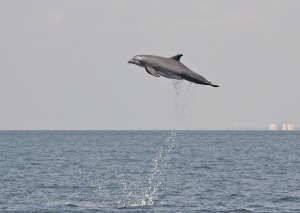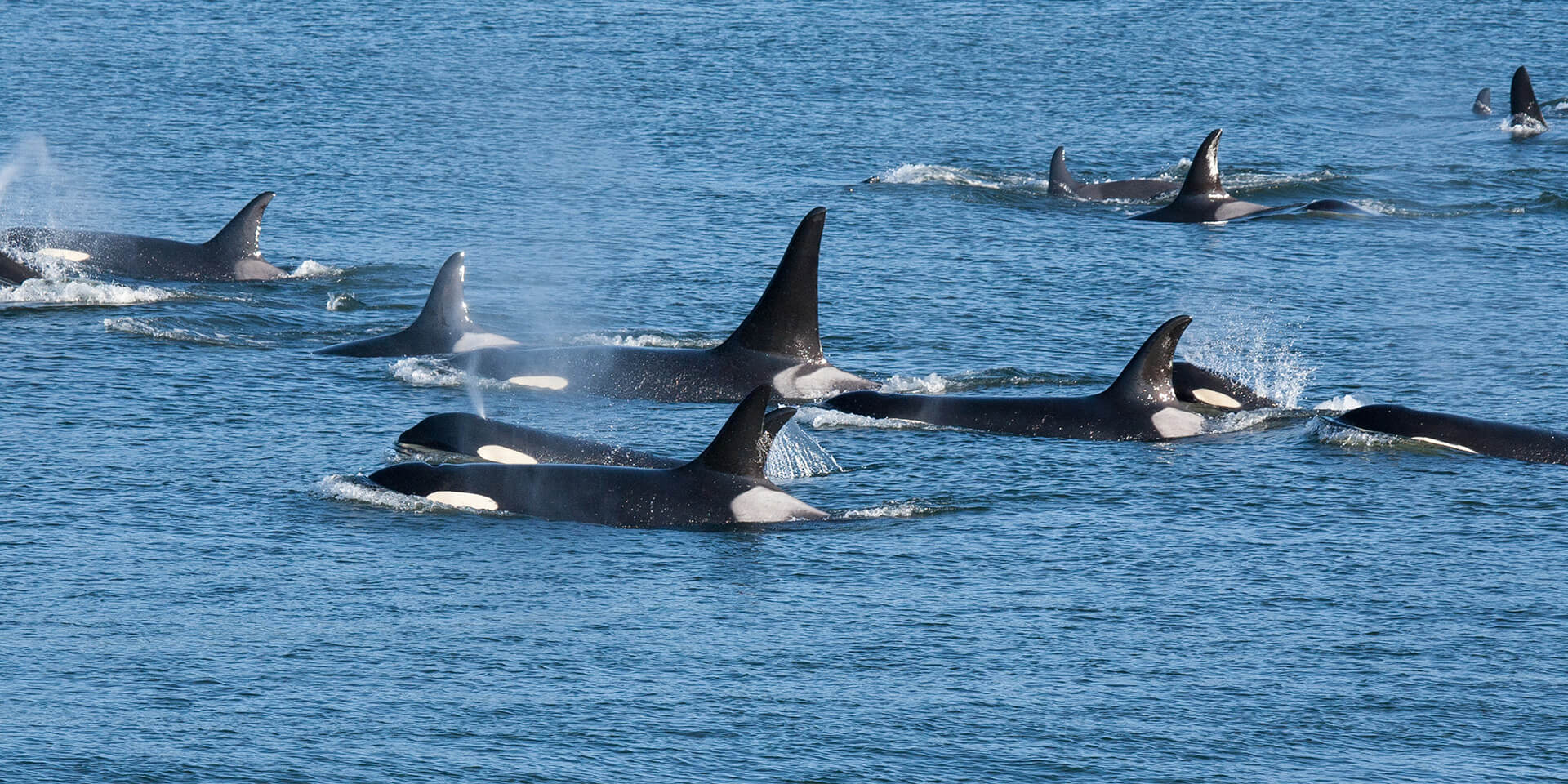Effects of Low Salinity Exposure on Bottlenose Dolphins Webinar
Meeting of the Marine Mammal Commission and Committee of Scientific Advisors on Marine Mammals
Effects of Low-Salinity Exposure on Bottlenose Dolphins
March 23, 2021
The webinar was recorded and is available for viewing here.
Update: Subsequent to the webinar, the Commission requested additional analyses on the potential effects of the proposed Mid-Barataria Sediment Diversion project in Barataria Bay, Louisiana, on recovery of the Barataria Bay stock of common bottlenose dolphins, and how the project might delay the stock’s recovery from the effects of the 2010 Deepwater Horizon oil spill. A copy of that request and results of that analysis are available here. In 2022, researchers published a final report, following the Commission’s initial request, which is available here.
Objective: Provide update on the status of the Barataria Bay stock of common bottlenose dolphins, review the findings of the northern Gulf of Mexico bottlenose dolphin unusual mortality event (UME), provide information on the potential impacts of low-salinity exposure on dolphins and their prey, identify data needs, and discuss options for mitigating and monitoring impacts to dolphins and their prey from future low-salinity exposure.
Presentations:

Photo taken under NOAA permit # 779-1633. (NOAA SEFSC)
Status of the Barataria Bay dolphin population 10 years after the Deepwater Horizon oil spill – Dr. Lori Schwacke, National Marine Mammal Foundation (NMMF)
Overview of what we know about the pathogenesis, impacts, scenarios, and management needs of low salinity exposure on bottlenose dolphins using a synthesis of published and unpublished studies – Dr. Ryan Takeshita, NMMF; Contributors: Dr. Teri Rowles, National Marine Fisheries Service (NMFS), Dr. Erin Fougeres, NMFS; Dr. Kathleen Colegrove, University of Illinois at Urbana-Champaign; Dr. Alissa Deming, Pacific Marine Mammal Center (PMMC)
Circumstances and findings from the bottlenose dolphin UME in the northern Gulf of Mexico – Dr. Lance Garrison, NMFS; Dr. Alissa Deming, PMMC
Results from an Expert Elicitation of the effects of low salinity water exposure on bottlenose dolphins – Dr. Cormac Booth, SMRU Consulting, Inc., University of St. Andrews, UK
Predictive modeling to determine effects of low salinity on dolphins resulting from the operation of the large-scale sediment diversions in Louisiana – Dr. Lance Garrison, NMFS
Update on the status and timelines for Louisiana’s Mississippi River sediment diversion projects – Mr. Brian Lezina, Louisiana Coastal Protection and Restoration Authority
Panel Discussion – major findings, data needs, mitigation and monitoring options, and next steps
Meeting Format: This meeting was conducted in accordance with the requirements of the Government in the Sunshine Act and the Federal Advisory Committee Act.
Presenter biographies:
Dr. Lori Schwacke currently serves as Chief Scientist for Conservation Medicine at the National Marine Mammal Foundation (NMMF). Much of her recent research has focused on cetacean populations in the northern Gulf of Mexico. She led the Consortium for Advanced Research on Marine Mammal Health Assessment (CARMMHA), a GOMRI consortium that included 9 partner institutions and over 50 multidisciplinary researchers. The consortium’s goals were to improve capabilities to assess marine mammal health and to investigate the long-term impacts of oil spills. Prior to coming to NMMF, Dr. Schwacke was with NOAA, where she led efforts to assess and quantify injuries to Gulf of Mexico dolphin populations following the Deepwater Horizon oil spill. Dr. Schwacke holds a PhD in Biostatistics, Epidemiology, and Systems Science from the Medical University of South Carolina and a BS in Computer Science from Florida State University.
Dr. Ryan Takeshita is a research scientist with the National Marine Mammal Foundation’s Conservation Medicine Team. His research focuses on the effects of toxicants and environmental stressors on marine mammals, as well as identifying restoration options for impacted populations.
Dr. Lance Garrison is a research biologist in the Marine Mammal and Turtle Division at the National Marine Fisheries Service, Southeast Fisheries Science Center. He is a quantitative ecologist with expertise in marine mammal stock assessment, spatial ecology, and habitat analysis. He has worked on a broad range of topics related to marine mammal stock assessments in the southeastern United States including quantifying population sizes and trend, estimating bycatch mortality in commercial fisheries, and conducting risk assessments related to vessel strikes in large whales. He was a co-lead on the team that quantified injuries from the Deepwater Horizon oil spill on affected marine mammal populations and is actively involved in planning and implementation of associated restoration projects.
Dr. Alissa Deming is the Director of Clinical Medicine at the Pacific Marine Mammal Center in Laguna Beach, California. From 2018-2020 she was the veterinarian for Alabama Marine Mammal Stranding Network at Dauphin Island Sea Lab and is the on-site coordinator for the 2019 northern Gulf of Mexico bottlenose dolphin unusual mortality event. She received her Doctorate in Veterinary Medicine and PhD in Comparative, Diagnostic and Population Medicine from the University of Florida investigating urogenital carcinoma in California sea lions. She has strong background in marine mammal medicine, having worked as a clinical veterinarian at The Marine Mammal Center, Dauphin Island Sea Lab, SeaWorld San Diego, and the National Marine Mammal Foundation/NMMP. Her primary research interest is to study the disease patterns in marine mammal populations to better understand the impacts of human and environmental influences on ecosystem health.
Dr. Cormac Booth is a Principal Scientist at SMRU Consulting, at the University of St Andrews. He is interested in the potential impacts of anthropogenic stressors on marine mammals and today will be talking about his work developing and applying expert elicitation approaches to challenging marine problems.
Mr. Brian Lezina currently serves as the Chief of Planning for the Louisiana Coastal Protection and Restoration Authority. As such he oversees the development of Louisiana’s Comprehensive Master Plan for a Sustainable Coast; A plan used to guide the state’s integrated coastal restoration and protection program. In addition, the Planning Division is responsible for large-scale feasibility studies, management of several restoration and conservation programs, and the environmental permitting of restoration projects within the coastal area. Brian’s experience spans over 20 years in coastal wetland and estuarine ecology, restoration planning and regulation, and natural resources management in both state government and academia. He holds a B.S. in Wildlife and Fisheries Science from Louisiana State University and a M.S. in Coastal Sciences from the University of Southern Mississippi.
Background:
Booth, C., and L. Thomas. 2021. An expert elicitation of the effects of low salinity water exposure on bottlenose dolphins. Oceans 2(1):179-192.
Deming, A.C., N.L. Wingers, D.P. Moore, D. Rotstein, R.S. Wells, R. Ewing, M.R. Hodanbosi, and R.H. Carmichael. 2020. Health impacts and recovery from prolonged freshwater exposure in a common bottlenose dolphin (Tursiops truncatus). Frontiers in Veterinary Science 7:235.
Duignan, P.J., N.S. Stephens, and K. Robb. 2020. Fresh water skin disease in dolphins: a case definition based on pathology and environmental factors in Australia. Scientific Reports 10:21979.
Garrison, L.P, J. Litz, and C. Sinclair. 2020. Predicting the effects of low salinity associated with the Mid-Barataria Sediment Diversion project on resident common bottlenose dolphins (Tursiops truncatus) in Barataria Bay, Louisiana. NOAA Technical Memorandum NMFS-SEFSC-748. 97 pages.
Hornsby, F.E., T.L. McDonald, B.C. Balmer, T.R. Speakman, K.D. Mullin, P.E. Rosel, R.S. Wells, A.C. Telander, P.W. Marcy, K.C. Klaphake, and L.H. Schwacke. 2017. Using salinity to identify common bottlenose dolphin habitat in Barataria Bay, Louisiana, USA. Endangered Species Research 33:181–192.
McClain, A.M., R. Daniels, F.M. Gomez, S.H. Ridgway, R. Takeshita, E.D. Jensen, and C.R. Smith. 2020. Physiological effects of low salinity exposure on bottlenose dolphins (Tursiops truncatus). Journal of Zoological and Botanical Gardens 1:61–75.
White, E.D., F. Messina, L. Moss, and E. Meselhe. 2018. Salinity and marine mammal dynamics in Barataria Basin: Historic patterns and modeled diversion scenarios. Water 10:1015.
Mid-Barataria Sediment Diversion documents (Comments due June 3, 2021):
Louisiana Deepwater Horizon Trustee Implementation Group. 2021. Draft Phase II Restoration Plan #3.2: Mid-Barataria Sediment Diversion.
U.S. Army Corp of Engineers. 2021. Mid-Barataria Sediment Diversion Draft Environmental Impact Statement.
Commission letters related to proposed sediment diversions in Louisiana:
October 7, 2016 – Letter to the Gulf Coast Ecosystem Restoration Council on the RESTORE Act Draft Comprehensive Plan Update 2016 for the Gulf of Mexico.
For more information: Contact Victoria Cornish at vcornish@mmc.gov, (301) 504-0087, x209.
